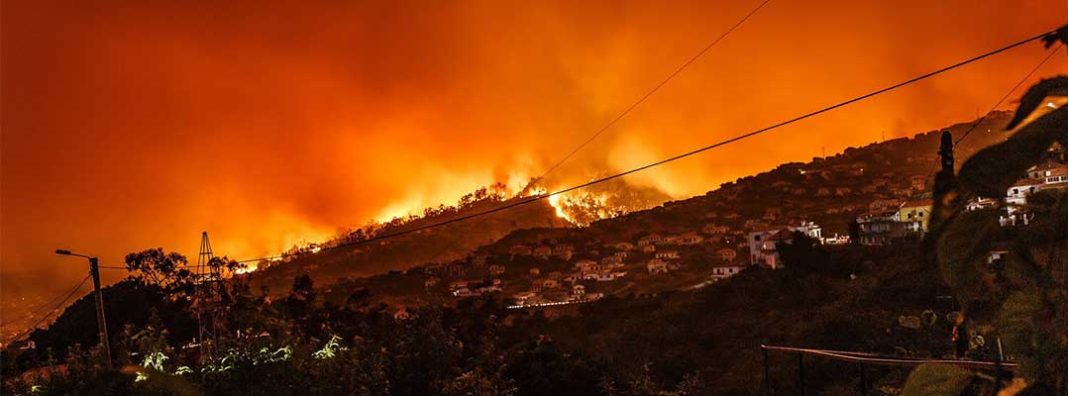
*This piece is the second of a multi-part series by Brian Isom on wildfires. Click to read parts one, three, and four.
Just over one month ago, Paradise, California, issued its first rebuild permit since the Camp Fire devastated the community last November. The town of 26,000 residents was all but wiped off the map, taking with it 86 lives. This made the Camp Fire the most destructive wildfire in California’s recorded history and reignited the debate around how we develop fire-prone landscapes. The Camp Fire alone resulted in $16.5 billion dollars in recorded losses, with the cost of battling the fire estimated at $82.2 million.
In last month’s essay, I explained how nearly a century of suppression-heavy fire management strategies has created western landscapes that are now more fire-prone. Removing fire from historically fire-adapted landscapes resulted in more densely-grown forests and a build-up of dead and dying underbrush.
At the end of 2017, for instance, the US Forest Service reported that there were a record-breaking 129 million dead trees in California. Eventually, this buildup of underbrush will either burn or have to be removed. To echo the words of Mark Finney, a fire scientist for the US Forest Service (USFS),
“A fire put out is a fire put off.”
Preventative measures such as managed burns can be used to reduce the risk of large-scale fires, but the longer we procrastinate dealing with this buildup, the higher the stakes become.
Wildfires pose a major risk to homes and communities located in a region known as the Wildland Urban Interface (WUI). This region includes any residential or commercial development located in close proximity for fire-prone landscapes. As WUI development grows, it puts more homes and lives in the path of wildfires and places an increasing strain on fire-fighting resources. More homes mean more lives at risk and more areas to protect. According to the USFS:
“[T]he WUI protection is the major component of FS’ escalating suppression expenditures, with [forest managers and staff] estimating that between 50 to 95 percent of large wildfire costs are directly related to protecting private property and homes in the WUI.”
Considering the USFS spent over $3 billion on wildfire suppression efforts in 2018, the costs of protecting homes in the WUI represents a sizeable chunk of money. At the same time, government-guaranteed fire protection decreases the risk many would-be homeowners must account for when building in the WUI. Failure to internalize these risks will encourage more homeowners to build in these at-risk areas, further depleting fire-management budgets. Many in the west are already suffering from that reality.
The town of Paradise, California is located in the foothills of the Sierra Nevada Mountains. The town’s website boasts, “Residents and visitors enjoy tall pines and majestic oaks, cooler summertime temperatures, occasional winter snowfalls, and an engaging environment.” Paradise is like so many other towns in the west. Situated in some of the most picturesque landscapes in the country, many grew out of early settlements established for mining or timber harvesting.
Recently, many of these small towns have seen levels of growth that are unmatched anywhere else in the country. Between 2010 and 2017, Western towns of fewer than 5,000 residents grew by 8 percent, whereas similar communities in the Northeast and Midwest shrank. In fact, all but the largest cities in the West are growing faster than the rest of the country, and even the largest only lag slightly behind Southern growth rates.
Source: U.S. Census
What does this growth mean for wildfire managers? Data on housing trends show that development along the WUI is the fastest growing land use type in the country. According to the newest data from the US Forest Service, 12.6 million homes were added to the WUI from 1990 to 2010, which equates to a 41 percent increase. The amount of new area added to the WUI over that same period is larger than the entire state of Washington.
The concern here is that as development continues to push out into wilderness areas, the number of homes and individuals at risk will grow. Already, nearly half of the Western population lives in the WUI and there is still plenty of room for that number to grow. A surprising 84 percent of the WUI in the West is still undeveloped. The 16 percent that is developed, however, is already a major liability for federal fire management.
To understand the impact fires are having on communities in the West, take a look at data on the growing number of structures burned by wildfires every year. From 2000 to 2009, the average number of structures (homes, businesses, etc) burned each year was 2,300. That yearly average jumped to 3,300 structures between 2010 and 2016. Then in 2017 something alarming happened: the number of structures destroyed jumped to 12,306 — nearly quadruple the average of the preceding 6 years. That number was topped again in 2018 when a staggering 25,790 structures were destroyed by wildfires. Not only is that 8 times the 2010–2016 average, it is 2,500 more structures than the total number burned between 2010 and 2016.
Still, for many residents in these areas, losing their homes to wildfire must seem like a very unlikely possibility. Even the 18,000 residences that burned last year make up a tiny fraction (less .05 percent) of the homes located in the WUI.
Builders and cities likewise face a number of incentives to continue development. New development means new residents, businesses, and tax revenues for cities. Many properties on hillsides and mountain slopes can fetch big money for contractors hoping to build luxury homes and cabins. As Volker Radeloff, professor of forestry at the University of Wisconsin puts it,
“There’s a lot of money to be made by building there. My gut feeling is that people know it’s a problem, but walking away from those economic opportunities is hard.”
That isn’t to say the issue can’t be fixed, but until homeowners and developers are responsible for the paying the costs associated with living in these high-risk areas, development is going to continue to expand in the West.
The relationship between homeowners in the WUI and federal fire management creates a situation economists refer to as a moral hazard. A moral hazard arises when individuals disregard or downplay risks related to decisions they make because they are provided some form of protection from that risk. In this case, homeowners building or buying homes in the WUI receive an implicit subsidy from the federal government by way of guaranteed fire protection.
A recent Stanford working paper quantifies the level of subsidies homeowners are receiving through this fire-suppression guarantee. In other words, what is the expected present value to homeowners of all future federal firefighting costs? The answer, it turns out, is quite a lot. The authors of the study find that on average the value of that suppression guarantee is 1.8 percent of the property value of the protected home. For the top 5 percent of homes benefitting from federal fire protection, that value is 7 percent of their property value. The top 1 percent of homes receive an estimated benefit equal to 20 percent of their property value.
These estimates imply that a substantial subsidy is being provided for homeowners in the WUI. This subsidy from taxpayers to homeowners is likely affecting their decision to move to fire-prone areas and their subsequent decisions about to what extent they will protect their home from fire risk. Political solutions thus far have done little to solve the problem — attempts at curbing spending have seldom been effective or lasted very long. Improvements in zoning and insurance markets, however, may help to reduce this moral hazard and the burden it places on federal taxpayers.
In Paradise, for instance, not all homes were destroyed by the Camp Fire. There were some that survived, and many of them share a common characteristic: they were built after 2008 when California imposed stricter building codes in fire-prone areas. These laws require things like fire-resistant roofing and siding. Over half of the homes built after 2008 in Paradise survived the burn, versus just 18 percent of homes built before 2008. The cost of building a fire resistant home is not much more than that of a normal home, meaning California’s housing stock should become more fire resistant over time. Unfortunately, the majority of homes currently located in the WUI were built before 2008, and retrofitting those homes to bring them up to code requires a significant investment.
This is also an opportunity for insurance companies to play an important role in encouraging risk-reducing behaviors. Already, homeowners in California are having a difficult time finding insurance after two record-breaking fire years. Insurers are taking a harder look at the homes they insure and raising the cost of insurance coverage for many homes in the WUI. This is surely a hard pill for many homeowners to swallow but is also a natural correction. Higher costs reflect the higher risks homeowners face when moving to the WUI.
At the same time, instead of raising costs, insurers can offer other incentives to homeowners and communities that take steps to protect themselves. Much like many auto insurance companies provide lower rates for taking defensive driving training or going so many years without an accident or speeding ticket, home insurers can provide breaks to homeowners and communities that create defensible spaces by removing trees near structures and creating natural fire breaks, or install fire-resistant materials on buildings. A new $10,000 roof may be more appealing if it can also save you hundreds or thousands of dollars on your home insurance each year.
Like suppression efforts of the past century, federally funded fire protection has solved one problem by creating a much larger one. The culmination of these efforts is a growing exposure of Western populations to the devastation of wildfires, and growing dependence of those same people on federal firefighting expenditures. It is time to re-examine how we develop the WUI, and how we plan to reconcile our growing desire to live in Western landscapes. Those who want to build in Western WUI areas should be free to do so, but they should incur the costs of these decisions. By constructing public policies that encourage homeowners to account for the costs of living in fire-prone areas, we can ensure that the future of places like Paradise is built to withstand the next Camp Fire.


